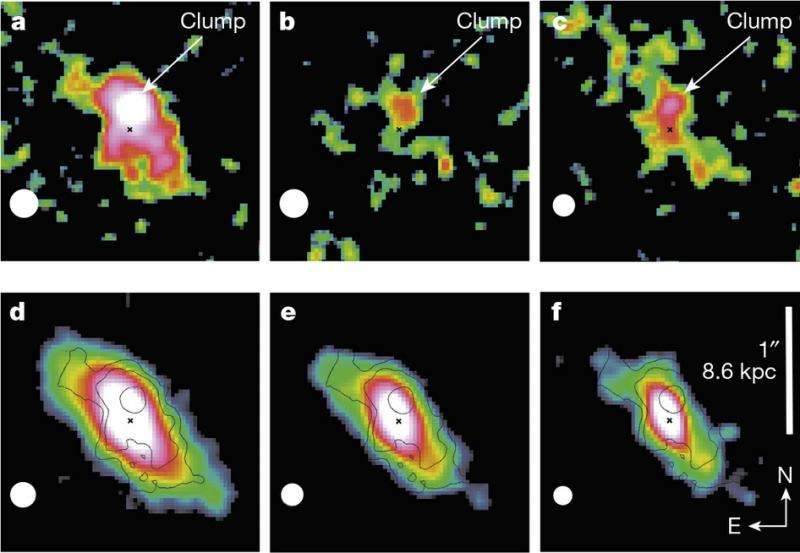May 7, 2015 report
Researchers report first observation of early stages of creation of a star-forming clump

(Phys.org)—An international team of space scientists has identified and observed the early stages of the creation of a star-forming clump, the first ever observed. In their paper published in the journal Nature, the team describes how they analyzed imaging and spectroscopy from the Hubble Space telescope to identify the clump, which they believe is likely to one day form a star.
As the team reports, star forming clumps come about in dense clouds of gas and dust which are known as dark nebulae—in such clouds, particularly in dense portions, the materials tend to coalesce due to gravitational attraction, into clumps—these clumps eventually evolve into proto-stars, and then finally stars. The galaxy under observation (in the cluster CL J144910856) was calculated to have come into existence approximately three billion years after the Big Bang—making it less than ten million years old. Dark nebulae that produce stars are known informally as star factories and the team suggests that they are responsible for the formation of the central bulge in spiral galaxies. They estimate the clump they have been studying has up to a billion bits of material and note that it was only because of the very high resolution offered by the Hubble telescope that they were able to make the discovery at all. They also suggest that their observations indicate that star formation regions are rare, but when they do exist, tend to have a very long lifespan. Thus far, they report, they have studied 68 galaxies in the cluster for signs of rapid star formation.
It is hoped that the finding by the team will lead to a better understanding of star formation and by extension, galaxy formation, particularly in the early years of the universe. The clump under observation in this latest observation is believed to be very young, which could offer clues as to its initial state—currently the process by which clumps start to form is not really understood.
The researchers suggest that many more such clumps, particularly larger samples, will need to found and studied before true insights into the nature of early star formation can be gained.
More information: An extremely young massive clump forming by gravitational collapse in a primordial galaxy, Nature, 521, 54–56 (07 May 2015) DOI: 10.1038/nature14409 . Arxiv: xxx.tau.ac.il/abs/1505.01290
Abstract
When cosmic star formation history reaches a peak (at about redshift z ≈ 2), galaxies vigorously fed by cosmic reservoirs are dominated by gas and contain massive star-forming clumps, which are thought to form by violent gravitational instabilities in highly turbulent gas-rich disks. However, a clump formation event has not yet been observed, and it is debated whether clumps can survive energetic feedback from young stars, and afterwards migrate inwards to form galaxy bulges. Here we report the spatially resolved spectroscopy of a bright off-nuclear emission line region in a galaxy at z = 1.987. Although this region dominates star formation in the galaxy disk, its stellar continuum remains undetected in deep imaging, revealing an extremely young (less than ten million years old) massive clump, forming through the gravitational collapse of more than one billion solar masses of gas. Gas consumption in this young clump is more than tenfold faster than in the host galaxy, displaying high star-formation efficiency during this phase, in agreement with our hydrodynamic simulations. The frequency of older clumps with similar masses, coupled with our initial estimate of their formation rate (about 2.5 per billion years), supports long lifetimes (about 500 million years), favouring models in which clumps survive feedback and grow the bulges of present-day galaxies.
Journal information: Nature
© 2015 Phys.org



















